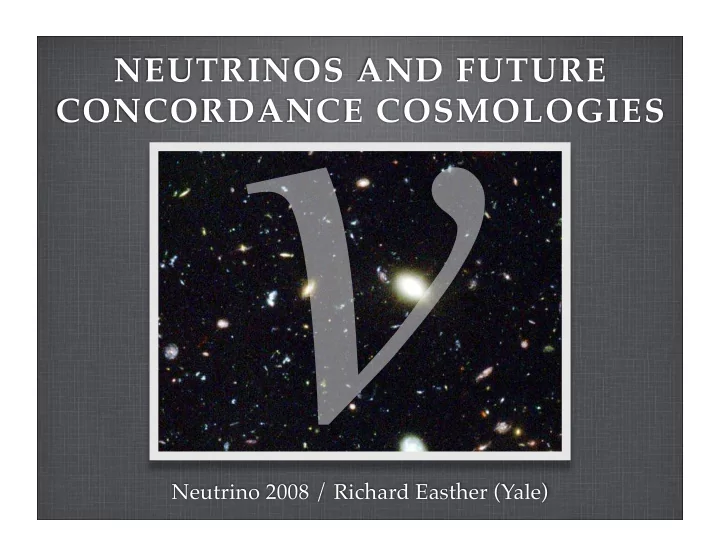

� NEUTRINOS AND FUTURE CONCORDANCE COSMOLOGIES Neutrino 2008 / Richard Easther (Yale)
INTRODUCTION... Integrated History of the Universe... Probes: CMB Large scale structure 21 cm Summary...
C OSMOLOGY : O VERVIEW Image: NASA
C OSMOLOGY : O VERVIEW Overall expansion... Image: NASA
C OSMOLOGY : O VERVIEW { Stars, galaxies... Image: NASA
C OSMOLOGY : O VERVIEW Dark Ages... Image: NASA
C OSMOLOGY : O VERVIEW Microwave Background Image: NASA
C OSMOLOGY : O VERVIEW “Big Bang” Inflation � +BBN Image: NASA
CONCORDANCE COSMOLOGY Baryon fraction Baryogenesis � b (Mass known, #??) (? - GUT, Electroweak?) Dark matter TeV Scale physics?? � CDM (Mass ??, #??) Supersymmetry? LHC? Quantum Gravity Cosmological constant � � Tooth fairy? First stars (gastrophysics, Reionization � nuclear physics) h Hubble’s “constant” When we are looking Primordial Inflation A s ,n s Perturbations GUT/string physics?
THE FUTURE... Parameter set will expand Neutrino sector! Scale dependence of n? Dark energy parameters? Tensor modes? Helium fraction? Curvature? Secondary anisotropies? Parameter set will shrink Neutrino masses from experiments? Recombination observed directly in 21cm? Specific models of inflation?
NUMBERS... Photons: T � = 2.726 K = 2.35 10 -4 eV (measured) Massless � : T � ~ 1.9K = 1.7 10 -4 eV (inferred) Photons at z = 1,089: T � = 2.97 10 3 K = 0.255 eV Massless � : T � ~ 2.07 10 3 K = .17 eV Minimum � m � ~ 0.05 eV (normal hierarchy) Change in equation of state as universe expands!
CMB: WMAP
BEST FIT Early universe is a simple system General relativity and small inhomogeneities e - , p, He nuclei, dark matter, � , � , also � , H o and k Boltzmann equations Beautiful and largely classical classical physics Compute C l & polarization (E and B mode)
THE SPECTRAL INDEX
THE BARYON FRACTION
HUBBLE PARAMETER
WHAT DO WE LEARN? WMAP 5 + Count the significant figures... Cosmology graduated from back of the envelope!
TOTAL NEUTRINO MASS
ERROR FORECASTS (Rough & Overly Optimistic) � m Planck’ “Ideal” Perfect H 0
CURRENT CONSTRAINTS WMAP5 + All Komatsu et al. Care needed Priors Systematics between datasets � m � < ~1eV
LARGE SCALE STRUCTURE
LARGE SCALE STRUCTURE & LENSING Galaxies clustered in space Bubbles and voids Orthogonal information to microwave background Large scale structure Get power spectrum P(k) Break degeneracies Nonlinear at short scales (function of redshift)
MATTER POWER...
HIGH-REDSHIFT 21CM � Before first stars, universe is mostly neutral H Neutral hydrogen emits a 21cm line Redshifted; H at redshift 10: 2.1 meters.
HIGH-REDSHIFT 21CM Observe sky at ~100 MHz Remove foregrounds (!) Map neutral hydrogen density as a function of z Needs radio-quiet location Get “slices” by tuning receiver
(Steve Furlanetto)
HIGH-REDSHIFT 21CM Instruments Mileura (Australia) LOFAR (Belguim) SKA (To be decided) Lunar Array (Far side of the moon / vaporware!)
PROSPECT FOR NEUTRINOS First observations: “Low” redshift Focus on reionization / first stars Longer term: High redshift Weaker signal Probe short wavelengths (uncollapsed) Perturbations small ; challenging experiments Foregrounds??? Terrestrial noise???
A BOLD PREDICTION? Total mass: 0.3eV Nonlinear scales at z=0.3,4 and 8 Pritchard and Pierpaoli
A BOLD PREDICTION? Total mass 0.12eV Both hierarchies Solid z=8 Theoretically distinguishable Pritchard and Pierpaoli
COMMENTS AND CONCLUSIONS... Neutrinos provide definite target Very good reason to believe they are there (WMAP) We know their total mass is non-zero Probe thermal history of very early universe Small effect: precision cosmology Terrestrial measurements of neutrino mass constrain other cosmological parameters
COMMENTS AND CONCLUSIONS... Current bound ~10 times larger than minimum � m Next few years: Planck, ACT, EBEX, DEC Better SN1a bounds & BAO, first 21cm data Somewhat longer term: JDEM, LSST, CMBPol (?) Very long term: High precision high-z 21cm GUESS: A factor of 10 on � m in 10 years??
Recommend
More recommend